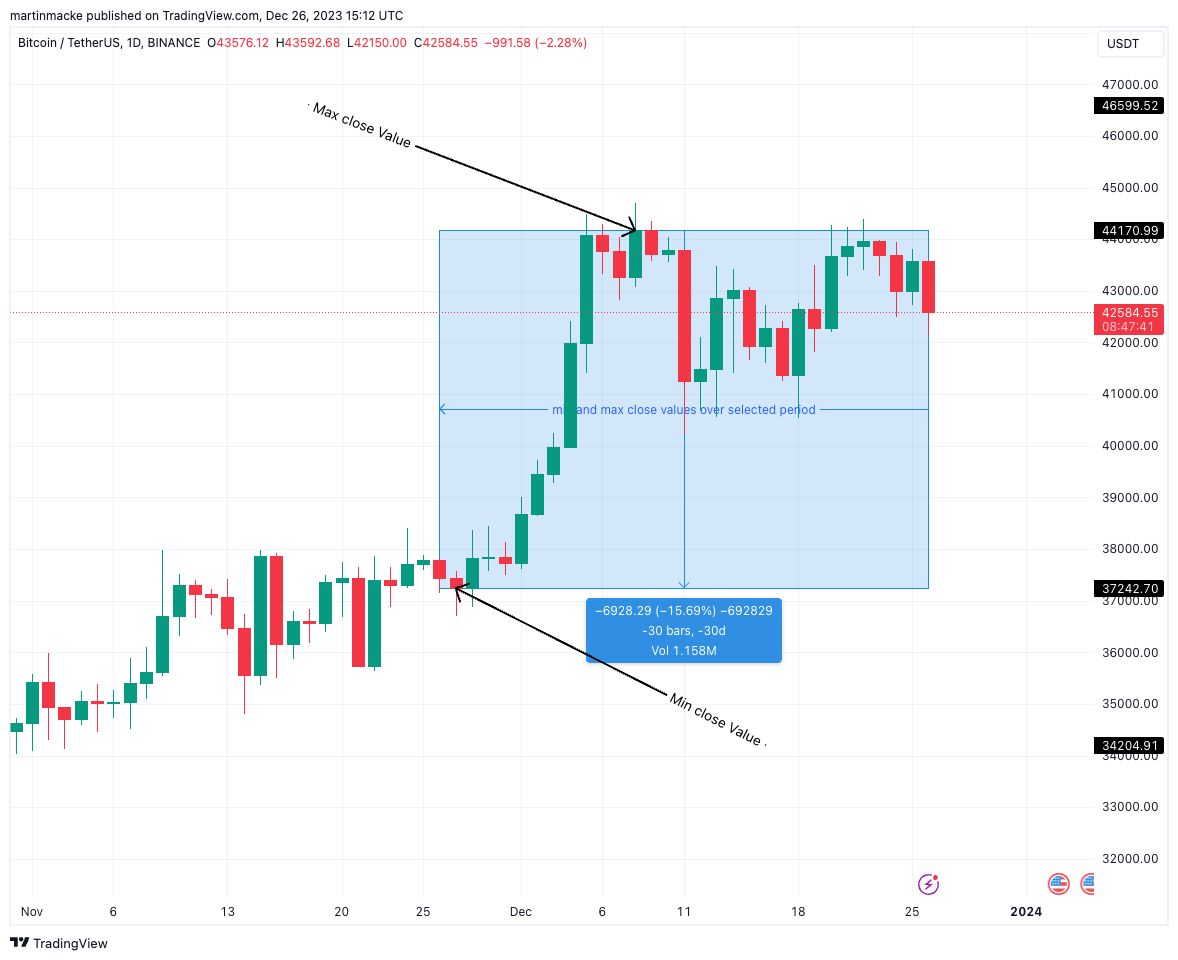Lowest and highest values over a specified period
The minmax technical indicator is used to identify the minimum and maximum closing prices within a specified set of candles.
Lowest and Highest close values
The closing prices represent the final values of an asset at the end of each trading period, such as a day or an hour. It is important to understand that the minmax returns the min and max close values, not the lowest low or a highest high, for example.
- If you’re looking to find the lowest
lowover a specific period, use the priorswinglow - If you’re looking to find the highest
highover a specific period, use the priorswinghigh

Understand the basics
- The MinMax indicator focuses on the closing prices of candles.
- It calculates the minimum (lowest) and maximum (highest) closing prices within a specified
period.
Default Settings
- The default
periodfor the MinMax indicator is set to30candles. This means it will analyze the closing prices of the last30candles unless otherwise specified.
Specify the Period (Optional)
- If you want to analyze a different number of candles, you can use the optional
periodparameter. For example, if you want to analyze the last20candles, set theperiodparameter to20.
Get started with the minmax
Simply make an HTTPS [GET] request or call in your browser:
[GET] https://api.taapi.io/minmax?secret=MY_SECRET&exchange=binance&symbol=BTC/USDT&interval=1h
API response
The minmax endpoint returns a JSON response like this:
{
"valueMin": 34260.7,
"valueMax": 39660.92
}
Example response from TAAPI.IO when querying minmax endpoint.
API parameters
binance, binancefutures or one of our supported exchanges. For other crypto / stock exchanges, please refer to our Client or Manual integration methods.
BTC/USDT Bitcoin to Tether, or LTC/BTC Litecoin to Bitcoin...
1m, 5m, 15m, 30m, 1h, 2h, 4h, 12h, 1d, 1w. So if you're interested in values on hourly candles, use interval=1h, for daily values use interval=1d, etc.
backtrack parameter removes candles from the data set and calculates the minmax value X amount of candles back. So, if you are fetching the minmax on the hourly and you want to know what the minmax was 5 hours ago, set backtrack=5. The default is 0.
chart parameter accepts one of two values: candles or heikinashi. candles is the default, but if you set this to heikinashi, the indicator values will be calculated using Heikin Ashi candles. Note: Pro & Expert Plans only.
true or false. Defaults to false. By setting to true the API will return a timestamp with every result (real-time and backtracked) to which candle the value corresponds. This is especially helpful when requesting a series of historical values using the results parameter.
1685577600
1731456000 If you only use fromTimestamp, the API will return all results from that time until present.
number or max. Use this parameter to access historical values on the past X candles until the most recent candle. Use max to return all available historical values. Returns an array with the oldest value on top and most recent value returned the last.
Default: 30
More examples
Let's say you want to know the minmax value on the last closed candle on the 30m timeframe. You are not interest in the real-time value, so you use the backtrack=1 optional parameter to go back 1 candle in history to the last closed candle.
[GET] https://api.taapi.io/minmax?secret=MY_SECRET&exchange=binance&symbol=BTC/USDT&interval=30m&backtrack=1
Get minmax values on each of the past X candles in one call
Let's say you want to know what the minmax daily value was each day for the previous 10 days. You can get this returned by our API easily and efficiently in one call using the results=10 parameter:
[GET] https://api.taapi.io/minmax?secret=MY_SECRET&exchange=binance&symbol=BTC/USDT&interval=1d&results=10
Looking for even more integration examples in different languages like NodeJS, PHP, Python, Curl or Ruby? Continue to [GET] REST - Direct documentation.
